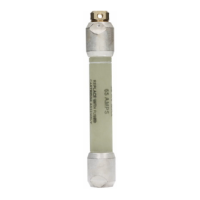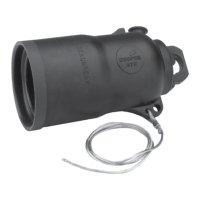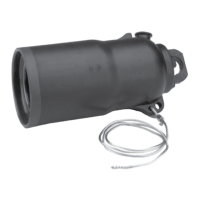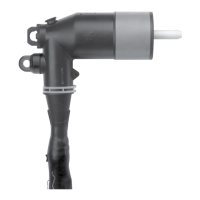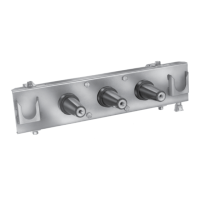8 type vsa12, vsa12b, vsa16, vsa20, and vsa20a operation and installation instructions MN280063EN May 2017
Accessories
Auxiliary switch
A one-, two-, three-, or four-stage auxiliary switch can be
provided as an accessory. Each stage has two independent
contacts that permit any desired combination of “a”
(follow state of recloser contacts) and “b” (opposite state
of recloser contacts) positions. The switch is wired to a
separate terminal block as shown in Figure 5.
The switch contacts are insulated for 600 V and have a
continuous current rating of 10 A. Their interrupting ratings
are shown in Table 7.
Table 7. Auxiliary Switch Interrupting Ratings
Volts
Inductive
AC (amps)
Non-
Inductive
AC (amps)
Inductive
DC (amps)
Non-
Inductive
DC (amps)
24 – – 15.0 20.0
48 – – 7.5 10.0
120 60 80 – –
125 – – 1.5 2.0
240 30 60 – –
250 – – 0.45 0.5
Current transformers
WARNING
Hazardous voltage. The equipment is shipped with
the shorting thumbscrews in the CT terminal blocks.
These thumbscrews must not be removed until external
connections are made to the terminal blocks. Energizing
the equipment with the shorting screws removed,
and no load connected, will cause high voltage to be
generated in the CT secondaries. Contact with high
voltage can cause severe personal injury or death and
equipment damage.
T208.2
Multi-ratio bushing current transformers can also be
supplied in either 600:5 or 1200:5 A ratios. Each multi-
tapped CT secondary is wired to a separate six-point
terminal block in the operator mechanism cabinet (Figure 5).
The available current ratios and terminal block terminations
are shown in Table 8.
Figure 6. Position of shorting thumbscrews.
Figure 7 shows one of the three terminal blocks for the
multi-ratio bushing CTs in the as-shipped condition. The
secondary of each CT is shorted and grounded by the
thumbscrew which shorts terminals X1 and X5 to the
grounding bar. After external connections are made, the
thumbscrew at X1 is removed and stored in the corner of
the terminal block. The other thumbscrew remains in the
grounding bar to make the common ground connection for
one side of the CT secondary winding. The location of the
screw in the bar is dependent upon the CT ratio desired and
is always the higher of the two terminal numbers. Typical
customer wiring to the three terminal blocks is shown in
Figure 7.
Table 8. Multi-Ratio Current Transformer Ratios and
Terminal Connections
600:5 Ratio BCT 1200:5 Ratio BCT Terminal Connection
600:5 1200:5 X1-X5
500:5 100:5 X2-X5
450:5 900:5 X3-X5
400:5 800:5 X1-X4
300:5 600:5 X2-X4
250:5 500:5 X3-X4
200:5 400:5 X4-X5
150:5 300:5 X1-X3
100:5 200:5 X1-X2
50:5 100:5 X2-X3
GRD X5 X4 X3 X2 X1
GRD X5 X4 X3 X2 X1
GRD X5 X4 X3 X2 X1
GRD X5 X4 X3 X2 X1
GRD X5 X4 X3 X2 X1GRD X5 X4 X3 X2 X1
Ground
Shorting
Screws
Common Return Connections
(Terminal X4 ground through shorting screws)
Permanently
Wired to CTs
Ground
Permanently
Wired to CTs
Shorting
Screws
Individually Wired Connections
Figure 7. Position-shorting thumbscrews in terminal block and customer wiring.

